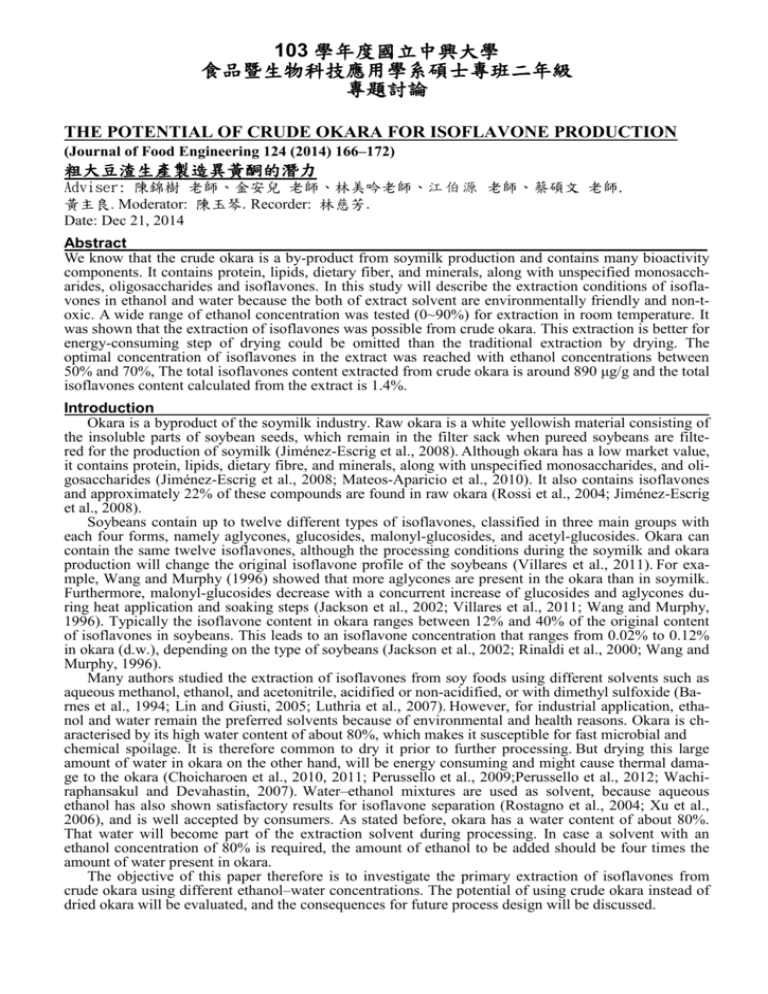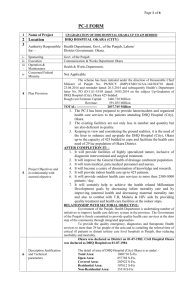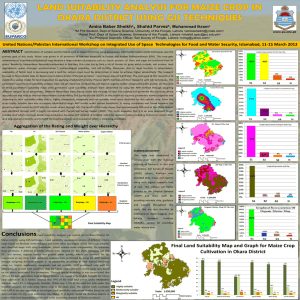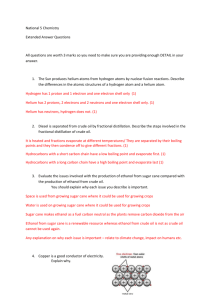粗大豆渣生產製造異黃酮的潛力 - 國立中興大學食品暨應用生物科技學系
advertisement

103 學年度國立中興大學 食品暨生物科技應用學系碩士專班二年級 專題討論 THE POTENTIAL OF CRUDE OKARA FOR ISOFLAVONE PRODUCTION (Journal of Food Engineering 124 (2014) 166–172) 粗大豆渣生產製造異黃酮的潛力 Adviser: 陳錦樹 老師、金安兒 老師、林美吟老師、江 伯 源 老師、蔡碩文 老師. 黃主良. Moderator: 陳玉琴. Recorder: 林慈芳. Date: Dec 21, 2014 Abstract We know that the crude okara is a by-product from soymilk production and contains many bioactivity components. It contains protein, lipids, dietary fiber, and minerals, along with unspecified monosaccharides, oligosaccharides and isoflavones. In this study will describe the extraction conditions of isoflavones in ethanol and water because the both of extract solvent are environmentally friendly and non-toxic. A wide range of ethanol concentration was tested (0~90%) for extraction in room temperature. It was shown that the extraction of isoflavones was possible from crude okara. This extraction is better for energy-consuming step of drying could be omitted than the traditional extraction by drying. The optimal concentration of isoflavones in the extract was reached with ethanol concentrations between 50% and 70%, The total isoflavones content extracted from crude okara is around 890 μg/g and the total isoflavones content calculated from the extract is 1.4%. Introduction Okara is a byproduct of the soymilk industry. Raw okara is a white yellowish material consisting of the insoluble parts of soybean seeds, which remain in the filter sack when pureed soybeans are filtered for the production of soymilk (Jiménez-Escrig et al., 2008). Although okara has a low market value, it contains protein, lipids, dietary fibre, and minerals, along with unspecified monosaccharides, and oligosaccharides (Jiménez-Escrig et al., 2008; Mateos-Aparicio et al., 2010). It also contains isoflavones and approximately 22% of these compounds are found in raw okara (Rossi et al., 2004; Jiménez-Escrig et al., 2008). Soybeans contain up to twelve different types of isoflavones, classified in three main groups with each four forms, namely aglycones, glucosides, malonyl-glucosides, and acetyl-glucosides. Okara can contain the same twelve isoflavones, although the processing conditions during the soymilk and okara production will change the original isoflavone profile of the soybeans (Villares et al., 2011). For example, Wang and Murphy (1996) showed that more aglycones are present in the okara than in soymilk. Furthermore, malonyl-glucosides decrease with a concurrent increase of glucosides and aglycones during heat application and soaking steps (Jackson et al., 2002; Villares et al., 2011; Wang and Murphy, 1996). Typically the isoflavone content in okara ranges between 12% and 40% of the original content of isoflavones in soybeans. This leads to an isoflavone concentration that ranges from 0.02% to 0.12% in okara (d.w.), depending on the type of soybeans (Jackson et al., 2002; Rinaldi et al., 2000; Wang and Murphy, 1996). Many authors studied the extraction of isoflavones from soy foods using different solvents such as aqueous methanol, ethanol, and acetonitrile, acidified or non-acidified, or with dimethyl sulfoxide (Barnes et al., 1994; Lin and Giusti, 2005; Luthria et al., 2007). However, for industrial application, ethanol and water remain the preferred solvents because of environmental and health reasons. Okara is characterised by its high water content of about 80%, which makes it susceptible for fast microbial and chemical spoilage. It is therefore common to dry it prior to further processing. But drying this large amount of water in okara on the other hand, will be energy consuming and might cause thermal damage to the okara (Choicharoen et al., 2010, 2011; Perussello et al., 2009;Perussello et al., 2012; Wachiraphansakul and Devahastin, 2007). Water–ethanol mixtures are used as solvent, because aqueous ethanol has also shown satisfactory results for isoflavone separation (Rostagno et al., 2004; Xu et al., 2006), and is well accepted by consumers. As stated before, okara has a water content of about 80%. That water will become part of the extraction solvent during processing. In case a solvent with an ethanol concentration of 80% is required, the amount of ethanol to be added should be four times the amount of water present in okara. The objective of this paper therefore is to investigate the primary extraction of isoflavones from crude okara using different ethanol–water concentrations. The potential of using crude okara instead of dried okara will be evaluated, and the consequences for future process design will be discussed. MATERIAL AND METHODS ●Production of crude okara (ASC50 soymilk system ; Pro-Soya Inc., Ottawa, Canada) Soybeans(1 kg) →Soaking( 2 h) → Grinding(Water : Soybeans → 7 : 1)→ Slurry → Heating (105℃ / 3 min) → Centrifuge & Filter →Soymilk Okara (1.5 kg) ●Extraction of Crude okara and Freeze-dried okara Crude Okara ↓ Freeze-Dried ↓ Extraction(Liquid*:Solid** = 10:1) (Ethanol / Water:0, 10, 20, 30, 40, 50, 60, 70, 80, 90 wt%) Rotator 240rpm/min Room temp./2 h ↓ Centrifuge 24,010g/30 min/4℃ ↓ ↓ ↓ Extract Pellet ↓ Stored in -18℃ Crude Okara ↓ Freeze-Dried ↓ Extraction(Liquid*:Solid***= 10:1) (Ethanol / Water:0, 10, 20, 30, 40, 50, 60, 70, 80, 90 wt%) Rotator 240rpm/min Room temp./2 h ↓ Centrifuge 24,010g/30 min/4℃ ↓ ↓ ↓ Extract Pellet ↓ Stored in -18℃ *is ethanol/water;** is crude okara;*** is freeze-dried crude okara ●HPLC analysis (By Reverses-Phase HPLC) ConditionsColumn:Waters Atlantis dc 18 (3 μm), 150 mm × 2.1 mm /Column temperature:40 ℃ Detector:Photodiode array detector (UltiMate 3000, Dionex) / Wavelenth:254 nm Soft:Dionex Chromeleon 7 Chromatography Data System Mobile phase:A-0.1% formic acid in Milli-Q water / B- 0.1% formic acid in acetonitrile ●Dry matter content The extracts were dried overnight in an oven at 40℃ and 40 m bar. (AOAC Method 925.10,1998) ●Protein content By Dumas (Thermo Scientific FlashEA 1112 Analyser). Methionine was used as a standard, and a conversion factor of 6.25 to calculate the amount of protein in a sample. ●Isoflavone concentration and purity Concentration = Dilution ratio × the concentration measured with HPLC Purity= The isoflavone concentration / the dry matter content of the extract ●Statistical analysis Data was analysed by ANOVA using SPSS version 20(SPSS Inc., Chicago, USA). Differences within the group were determined using Least Significant Difference (LSD) multiple comparison analysis(p<0.05). RESULTS AND DISCUSSION ●Comparison of different solvents The highest value for the isoflavone concentration was reached with 50% acetonitrile, though the difference with 50% ethanol was not statistically relevant (p > 0.05). ●Extract impurities and residue swelling Fig. 2. Shows that with water and 10% ethanol, the extract is milky white, indicating that not only other components are dissolved, but part of the matrix is dispersed in the extract. With higher ethannol concentration, the extract became much clearer, meaning that it contained less undissolved solids. Fig. 3. Shows the matrix swelling. The residue after extraction with water and 10% ethanol remained highly swollen, which can be attributed to okara’s high fibre content. ●Extractability of isoflavones from crude and dry okara Fig. 4. The influence of different ethanol concentrations on the extractability of isoflavones (μg/g solvent). (a) Total isoflavone content extracted from crude okara and freeze-dried okara (2 h extraction, room temperature), and (b) aglycones, glucosides, and malonyl-glucosides extracted from crude okara. ●Purity of the extracts Fig. 6. Shows the isoflavone concentration based on the total dry matter content of the extracts obtained. CONCLUSION ●The 50% ethanol seems a good solvent as it leads to good extraction yields (see Fig. 4a. & Fig. 6.), concentration in crude okara was around 900 μg/g and the based on the total dry matter content of the extracts is 1.4% (see Fig. Fig. 6.). Beside the yield, the liquid to solid ratio is around 6:1 (see Fig. 1. in origin paper). ●The study suggests a more efficient process for isoflavone extraction if the crude okara is used instead of dry material. No drying even keeps the isoflavones readily available in the water phase present in crude okara. REFERENCES Barnes, S., Kirk, M., Coward, L., 1994. Isoflavones and their conjugates in soy foods – extraction conditions and analysis by HPLC mass-spectrometry. Journal of Agricultural and Food Chemistry 42 (11), 2466–2474. Cederroth, C.R., Nef, S., 2009. Soy, phytoestrogens and metabolism: a review. Choicharoen, K., Devahastin, S., Soponronnarit, S., 2010. Performance and energy consumption of an impinging stream dryer for high-moisture particulatematerials. Drying Technology 28 (1), 20–29. Jiménez-Escrig, A., Tenorio, M.D., Espinosa-Martos, I., Rupérez, P., 2008. Healthpromoting effects of a dietary fiber from the soybean byproducts okara in rats. Journal of Agricultural and Food Chemistry 56, 7495~7501. Lin, F., Giusti, M.M., 2005. Effects of solvent polarity and acidity on the extraction efficiency of isoflavones from soybeans (glycine max). Journal of Agricultural and Food Chemistry 53 (10), 3795–3800. Luthria, D.L., Biswas, R., Natarajan, S., 2007. Comparison of extraction solvents and techniques used for the assay of isoflavones from soybean. Food Chemistry 105 (1), 325–333. Mateos-Aparicio, I., Mateos-Peinado, C., Jiménez-Escrig, A., Rupérez, P., 2010. Multifunctional antioxidante activity of polysaccharide fractions from the soybean byproduct okara. Carbohydrate Polymers 82, 245~250. Perussello, C.A., Mariani, V.C., do Amarante, A.C.C., 2012. Numerical and experimental analysis of the heat and mass transfer during okara drying.Applied Thermal Engineering 48, 325–331. Perussello, C.A., Mariani, V.C., do Amarante, A.C.C., 2009. Convective drying kinetics and darkening of okara. Drying Technology 27 (10), 1132–1141. Rossi, E.A., Rosier, I., Dâmaso, A.R., Vendramini, R.C., Carlos, I.Z., Abdalla, D.S.P., Talarico, V.H., Minto, D.F., 2004. Determinação de isoflavonas nas diversas etapas do processamento do iogurte de soja. Alimentos e Nutriçã~ 15, 93~99. Rostagno, M.A., Palma, M., Barroso, C.G., 2004. Pressurized liquid extraction of isoflavones from soybeans. Analytica Chimica Acta 522 (2), 169–177. Villares, A., Rostagno, M.A., Garcia-Lafuente, A., Guillamon, E., Martiez, J.A., 2011. Content and profile of isoflavones in soy-based foods as a function of the production process. Food and Bioprocess Technology 4 (1), 27–38. Wachiraphansakul, S., Devahastin, S., 2007. Drying kinetics and quality of okara dried in a jet spouted bed of sorbent particles. Lwt-Food Science and Technology 40 (2), 207–219. Wang, H.J., Murphy, P.A., 1996. Mass balance study of isoflavones during soybean processing. Journal of Agricultural and Food Chemistry 44 (8), 2377–2383 Xu, L., Kumar, A., Lamb, K., Layton, L., 2006. Recovery of isoflavones from red clover flowers by a membrane-based process. Innovative Food Science and Emerging Technologies 7 (3), 251–256.









